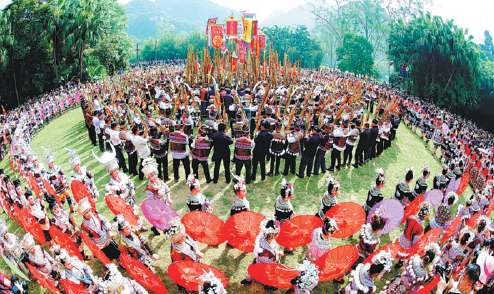Guangxi seeks revival through preservation

People sing folk songs and perform local dances in the Guangxi Zhuang autonomous region. CHINA DAILY
Autonomous region holds variety of events to boost cultural legacy
The Guangxi Zhuang autonomous region has endeavored to protect the vitality of the intangible cultural heritage and boost the innovative development of traditional cultures.
The region has formulated the Guangxi Intangible Cultural Heritage Evaluation and Evaluation Standards for Representative Inheritors to improve and refine evaluation indicators.
The number of intangible cultural heritage projects in the region has increased to 914.
Many cities have carried out the evaluation and identification of representative intangible cultural heritage projects.
Guangxi is continuing to enhance research and training in the inheritance of the national intangible cultural heritage and cooperated with Guangxi University for Nationalities and Guangxi University of Arts by holding four training courses in 2020. It has trained nearly 200 people and expanded its team of talents in traditional craft.
Publicity and activities
The region is holding a series of activities featuring unique folk songs and dances, costumes, local customs and cultural heritage.
On June 12, the Guangxi Department of Culture and Tourism and the Hechi government co-sponsored the intangible cultural heritage publicity and activities of the Non-Genetic Inheritance of Healthy Life in 2020 event, held in Bama Yao autonomous county.
The event not only carried out an intangible cultural heritage work symposium, project exhibitions, photography and displays, but also held the first Guangxi intangible cultural heritage shopping festival lighting ceremony.
The region has organized intangible cultural heritage related enterprises and intangible cultural heritage poverty alleviation workshops to carry out promotional activities and invited well-known online hosts to conduct live broadcasts on platforms such as Tencent, Toutiao, Pinduoduo and TikTok.
Those activities have integrated the intangible cultural heritage into the lives of the people and played a positive role in poverty alleviation and rural revitalization.
Focusing on the theme of "non-genetic inheritance of healthy life", 14 cities in the region have combined online activities with offline events.
To further the objective of intangible cultural heritage being used to promote rural revitalization and poverty alleviation, at the end of the resolute fight against poverty in 2020, the Guangxi Department of Culture and Tourism and the Guangxi Office in Beijing held the Magnificent Guangxi. Colorful Intangible Heritage-2020 Guangxi Intangible Heritage Helping Rural Revitalization and Poverty Alleviation (Beijing) exhibition.
The event showcased the region's fascinating and rich traditions of ethnic groups to all sectors of society with intangible cultural heritage craftsmanship products, exhibitions of famous and special products in 16 counties and districts and live broadcasts of online celebrities.
During the Cultural and Natural Heritage Day in June, Nanning organized activities such as the Intangible Heritage into the Community and Intangible Cultural Heritage into the Campus, with rich content and diverse forms.
Guilin has hosted Chinese Opera in Guilin Qingfeng Experimental School, Lingui Middle School, Guilin No 5 Middle School, Guilin Middle School, Guilin Feifeng Primary School, Guilin Dezhi Foreign Language School and Guilin Ronghu Primary School. More than 2,000 teachers and students watched the performance.
Qinzhou regularly launches intangible cultural heritage on campus, involving courses such as the Yandun Drum, Qinzhou Tea-Picking, Qinzhou Cantonese Opera, Qinzhou Haige and Qinzhou Nixing Pottery Production.
Guigang carries out intangible cultural heritage activities focusing on campuses, communities and the countryside in 2020 and a total of 13 events were held with about 15,000 participants.














